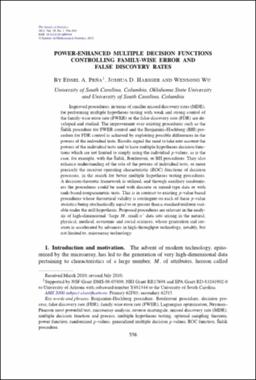| dc.contributor.author | Pena, Edsel A. | |
| dc.contributor.author | Habiger, Joshua D. | |
| dc.contributor.author | Wu, Wensong | |
| dc.date.accessioned | 2018-08-15T12:44:20Z | |
| dc.date.available | 2018-08-15T12:44:20Z | |
| dc.date.issued | 2011-02 | |
| dc.identifier | oksd_pena_powerenhancedmult_2011 | |
| dc.identifier.citation | Pena, E. A., Habiger, J. D., & Wu, W. (2011). Power-enhanced multiple decision functions controlling family-wise error and false discovery rates. Annals of Statistics, 39(1), 556-583. https://doi.org/10.1214/10-AOS844 | |
| dc.identifier.uri | https://hdl.handle.net/11244/301409 | |
| dc.description.abstract | Improved procedures, in terms of smaller missed discovery rates (MDR), for performing multiple hypotheses testing with weak and strong control of the family-wise error rate (FWER) or the false discovery rate (FDR) are developed and studied. The improvement over existing procedures such as the Sidak procedure for FWER control and the Benjamini-Hochberg (BH) procedure for FDR control is achieved by exploiting possible differences in the powers of the individual tests. Results signal the need to take into account the powers of the individual tests and to have multiple hypotheses decision functions which are not limited to simply using the individual p-values, as is the case, for example, with the Sidak, Bonferroni, or BH procedures. They also enhance understanding of the role of the powers of individual tests, or more precisely the receiver operating characteristic (ROC) functions of decision processes, in the search for better multiple hypotheses testing procedures. A decision-theoretic framework is utilized, and through auxiliary randomizers the procedures could be used with discrete or mixed-type data or with rank-based nonparametric tests. This is in contrast to existing p-value based procedures whose theoretical validity is contingent on each of these p-value statistics being stochastically equal to or greater than a standard uniform variable under the null hypothesis. Proposed procedures are relevant in the analysis of high-dimensional "large M, small n" data sets arising in the natural, physical, medical, economic and social sciences, whose generation and creation is accelerated by advances in high-throughput technology, notably, but not limited to, microarray technology. | |
| dc.format | application/pdf | |
| dc.language | en_US | |
| dc.publisher | Institute of Mathematical Statistics | |
| dc.rights | This material has been previously published. In the Oklahoma State University Library's institutional repository this version is made available through the open access principles and the terms of agreement/consent between the author(s) and the publisher. The permission policy on the use, reproduction or distribution of the material falls under fair use for educational, scholarship, and research purposes. Contact Digital Resources and Discovery Services at lib-dls@okstate.edu or 405-744-9161 for further information. | |
| dc.title | Power-enhanced multiple decision functions controlling family-wise error and false discovery rates | |
| osu.filename | oksd_pena_powerenhancedmult_2011.pdf | |
| dc.description.peerreview | Peer reviewed | |
| dc.identifier.doi | 10.1214/10-AOS844 | |
| dc.description.department | Statistics | |
| dc.type.genre | Article | |
| dc.type.material | Text | |
| dc.subject.keywords | benjamini-hochberg procedure | |
| dc.subject.keywords | bonferroni procedure | |
| dc.subject.keywords | false discovery rate | |
| dc.subject.keywords | family wise error rate | |
| dc.subject.keywords | lagrangian optimization | |
| dc.subject.keywords | microarray analysis | |
| dc.subject.keywords | reverse martingale | |
| dc.subject.keywords | missed discovery rate | |
| dc.subject.keywords | roc function | |
| dc.subject.keywords | sidak procedure | |
